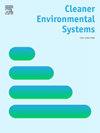纺织钢筋混凝土与结构混凝土的整体可持续性评估,以屋顶建筑为例
IF 4.9
Q2 ENGINEERING, ENVIRONMENTAL
引用次数: 0
摘要
由于气候要求的增加和劳动条件的变化,混凝土建筑面临着越来越多的可持续性挑战。纺织增强混凝土通过实现更轻、更节约资源的组件,提供了巨大的潜力。然而,评估这些系统需要超越以材料为基础的环境指标的整体方法。现有的框架往往忽视了制造、结构设计和更广泛的经济和社会方面之间的相互作用。本研究提出了一个整体评估模型,该模型在透明的多标准决策框架内整合了生态、经济和社会维度的36个标准。优势矩阵使基于利益相关者特定优先级的灵活加权成为可能。该模型应用于五种屋顶组件变体:带钢筋的现浇和预制平屋顶,带钢筋的预制外壳,以及两个纺织钢筋混凝土外壳——一个在现场手工喷涂,另一个使用自适应模板机器人制造。结果表明,纺织钢筋混凝土外壳具有重要的生态效益,与传统的平屋顶相比,可节省高达90%的材料,并且在所有变体中具有最低的全球变暖潜力。由于自动化的精密生产,预制的纺织品增强外壳达到了最高的整体可持续性得分。预制钢增强壳在可持续性尺寸的同等重量下排名第二,比传统平板减少60%的材料需求,强调了高效结构几何的可持续性潜力。虽然就地浇筑的平屋顶在经济上仍然具有优势,但预制方法(包括钢加固和纺织品加固)通过改善工作条件和最大限度地减少现场干扰,提供了显著的社会效益。开发的模型具有稳健性和可移植性,支持早期设计决策和对不同组件和施工策略的详细可持续性评估。本文章由计算机程序翻译,如有差异,请以英文原文为准。

Holistic sustainability assessment of textile-reinforced concrete compared to structural concrete using the example of a roof construction
Concrete construction faces growing sustainability challenges due to increasing climate requirements and changing labor conditions. Textile-reinforced concrete offers substantial potential by enabling lighter and more resource-efficient components. However, assessing such systems requires holistic methods that go beyond material-based environmental indicators. Existing frameworks often neglect the interactions between manufacturing, structural design, and broader economic and social aspects. This study presents a holistic evaluation model that integrates 36 criteria across ecological, economic, and social dimensions within a transparent multi-criteria decision-making framework. A dominance matrix enables flexible weighting based on stakeholder-specific priorities. The model is applied to five roof component variants: cast-in-place and precast flat roofs with steel reinforcement, a precast shell with steel reinforcement, and two textile-reinforced concrete shells—one manually sprayed on-site, the other produced robotically manufactured using adaptive formwork. The results show that textile-reinforced concrete shells offer major ecological benefits, with up to 90 % material savings compared to conventional flat roofs and the lowest global warming potential among all variants. The precast textile-reinforced shell achieves the highest overall sustainability score due to automated precision production. The precast steel-reinforced shell ranks second under equal weighting of sustainability dimensions and requires 60 % less material than conventional flat slabs, emphasizing the sustainability potential of efficient structural geometry. While cast-in-place flat roofs remain economically advantageous, precast methods—both steel- and textile-reinforced—offer notabel social benefits by improving working conditions and minimizing site disruptions. The developed model demonstrates robustness and transferability, supporting early design decisions and detailed sustainability assessments for diverse components and construction strategies.
求助全文
通过发布文献求助,成功后即可免费获取论文全文。
去求助
来源期刊

Cleaner Environmental Systems
Environmental Science-Environmental Science (miscellaneous)
CiteScore
7.80
自引率
0.00%
发文量
32
审稿时长
52 days
 求助内容:
求助内容: 应助结果提醒方式:
应助结果提醒方式:


